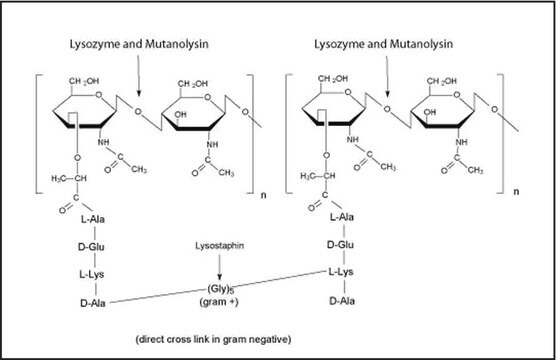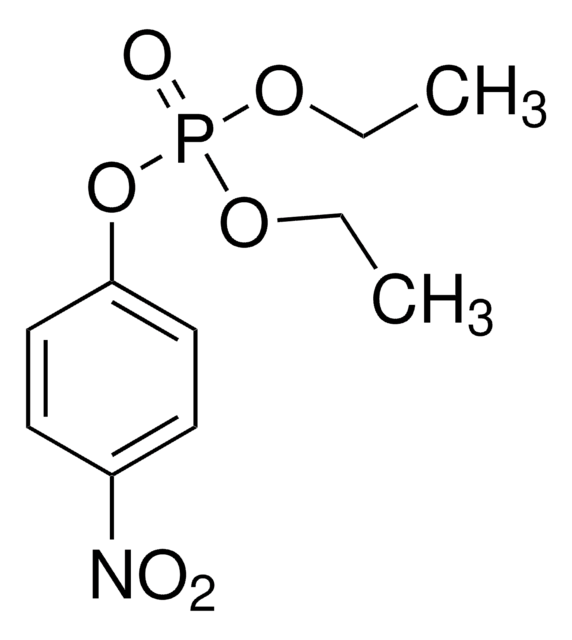Recommended Products
biological source
fermentation/recombinant
Quality Level
form
lyophilized solid
specific activity
≥30 U/mg
storage temp.
−20°C
Packaging
Bottomless glass bottle. Contents are inside inserted fused cone.
Unit Definition
One unit corresponds to the amount of enzyme which hydrolyzes 1 μmol diisopropyl fluorophosphate per minute at pH 8.1 and 22 °C
Signal Word
Danger
Hazard Statements
Precautionary Statements
Hazard Classifications
Resp. Sens. 1
Storage Class Code
11 - Combustible Solids
WGK
WGK 1
Flash Point(F)
Not applicable
Flash Point(C)
Not applicable
Personal Protective Equipment
dust mask type N95 (US), Eyeshields, Gloves
Certificates of Analysis (COA)
Search for Certificates of Analysis (COA) by entering the products Lot/Batch Number. Lot and Batch Numbers can be found on a product’s label following the words ‘Lot’ or ‘Batch’.
Already Own This Product?
Find documentation for the products that you have recently purchased in the Document Library.
Marc-Michael Blum et al.
Chemico-biological interactions, 187(1-3), 373-379 (2010-03-09)
The calcium-dependent phosphotriesterase diisopropyl fluorophosphatase (DFPase) from the squid Loligo vulgaris efficiently hydrolyzes a wide range of organophosphorus nerve agents. The two calcium ions within DFPase play essential roles for its function. The lower affinity calcium ion located at the
Gabriel Amitai et al.
The FEBS journal, 273(9), 1906-1919 (2006-04-28)
We addressed the ability of various organophosphorus (OP) hydrolases to catalytically scavenge toxic OP nerve agents. Mammalian paraoxonase (PON1) was found to be more active than Pseudomonas diminuta OP hydrolase (OPH) and squid O,O-di-isopropyl fluorophosphatase (DFPase) in detoxifying cyclosarin (O-cyclohexyl
Andreas R Günthert et al.
American journal of obstetrics and gynecology, 191(4), 1164-1172 (2004-10-28)
Eighty percent of human ovarian and endometrial cancers express receptors for luteinizing hormone-releasing hormone (LHRH-R). These receptors can be used for targeted chemotherapy with agents such as AN-152, in which doxorubicin is linked to analog [D-Lys(6)]-LHRH. Direct receptor-mediated antiproliferative effects
Jürgen Gäb et al.
Analytical biochemistry, 385(2), 187-193 (2008-12-17)
The enzyme diisopropyl fluorophosphatase (DFPase) from the squid Loligo vulgaris effectively catalyzes the hydrolysis of diisopropyl fluorophosphate (DFP) and a number of organophosphorus nerve agents, including sarin, soman, cyclosarin, and tabun. Up to now, the determination of kinetic data has
Robert C diTargiani et al.
Chemico-biological interactions, 187(1-3), 349-354 (2010-02-24)
A novel approach for treating organophosphorus (OP) poisoning is the use of enzymes, both stoichiometric and catalytic, as bioscavengers to sequester these compounds in circulation before they reach their physiological targets. Human serum butyrylcholinesterase and a recombinant form of this
Our team of scientists has experience in all areas of research including Life Science, Material Science, Chemical Synthesis, Chromatography, Analytical and many others.
Contact Technical Service









